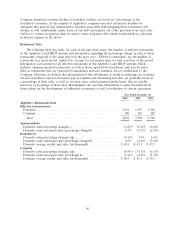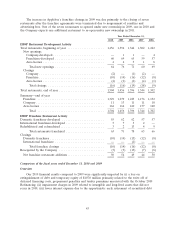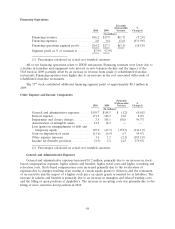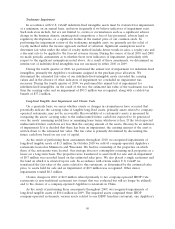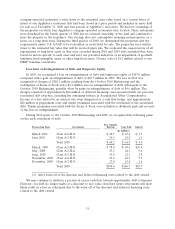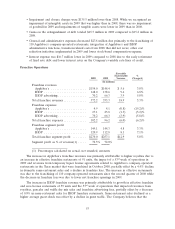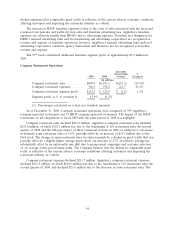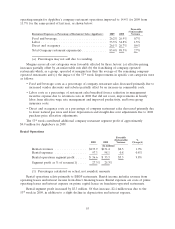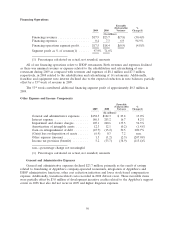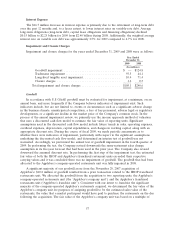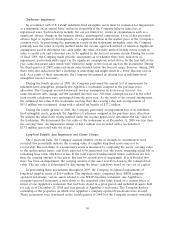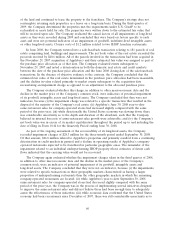IHOP 2010 Annual Report Download - page 66
Download and view the complete annual report
Please find page 66 of the 2010 IHOP annual report below. You can navigate through the pages in the report by either clicking on the pages listed below, or by using the keyword search tool below to find specific information within the annual report.Tradename Impairment
In accordance with U.S. GAAP, indefinite-lived intangible assets must be evaluated for impairment,
at a minimum, on an annual basis, and more frequently if we believe indicators of impairment exist.
Such indicators include, but are not limited to, events or circumstances such as a significant adverse
change in the business climate, unanticipated competition, a loss of key personnel, adverse legal or
regulatory developments, or a significant decline in the market price of our common stock. In
performing the impairment review of the tradename intangible asset, we primarily use the relief of
royalty method under the income approach method of valuation. Significant assumptions used to
determine fair value under the relief of royalty method include future trends in sales, a royalty rate and
a discount rate to be applied to the forecast revenue stream. During the course of fiscal 2010 and 2009,
we made periodic assessments as to whether there were indicators of impairment, particularly with
respect to the significant assumptions noted above. As a result of these assessments, we determined an
interim test of indefinite-lived intangibles was not necessary in either 2010 or 2009.
During the fourth quarter of 2010, we performed the annual test of impairment for indefinite-lived
intangibles, primarily the Applebee’s tradename assigned in the purchase price allocation. We
determined the estimated fair value of our indefinite-lived intangible assets exceeded the carrying
values and in the absence of other indicators of impairment we concluded no impairment was
necessary. During the fourth quarter of 2009, we performed the annual test of impairment for
indefinite-lived intangibles. As the result of the test, the estimated fair value of the tradename was less
than the carrying value and an impairment of $93.5 million was recognized, along with a related tax
benefit of $37.2 million.
Long-lived Tangible Asset Impairment and Closure Costs
On a quarterly basis, we assess whether events or changes in circumstances have occurred that
potentially indicate the carrying value of tangible long-lived assets, primarily assets related to company-
operated restaurants, may not be recoverable. Recoverability of a restaurant’s assets is measured by
comparing the assets’ carrying value to the undiscounted future cash flows expected to be generated
over the assets’ remaining useful lives or remaining lease terms, whichever is less. If the total expected
undiscounted future cash flows are less than the carrying amount of the assets, this may be an indicator
of impairment. If it is decided that there has been an impairment, the carrying amount of the asset is
written down to the estimated fair value. The fair value is primarily determined by discounting the
future cash flows based on our cost of capital.
As the result of performing these assessments throughout 2010, we recognized impairments of
long-lived tangible assets of $1.5 million. In October 2010 we sold 63 company-operated Applebee’s
restaurants located in Minnesota and Wisconsin. We had fee ownership of the properties on which
three of the restaurants were located. Our strategy does not contemplate retaining such properties as a
lessor on a long-term basis. The properties were transferred to assets held for sale and an impairment
of $0.7 million was recorded based on the estimated sales price. We also placed a single restaurant and
the land on which it is situated up for sale. In accordance with criteria under U.S. GAAP we
transferred the fair value of the assets related to this restaurant, as determined by the estimated sales
price, to assets held for sale and an impairment of $0.5 million was recognized. Other minor
impairments totaled $0.3 million.
Closure charges in 2010 of $2.0 million related primarily to two company-operated IHOP Cafe
restaurants (a non-traditional restaurant test format that was evaluated but will no longer be utilized)
and to the closure of a company-operated Applebee’s restaurant in China.
As the result of performing these assessments throughout 2009, we recognized impairments of
long-lived tangible assets of $10.4 million in 2009. The impaired assets comprised three IHOP
company-operated restaurants, various assets related to one IHOP franchise restaurant, one Applebee’s
50


